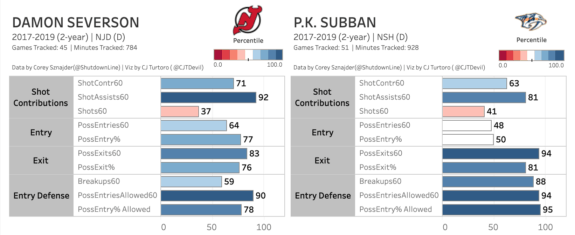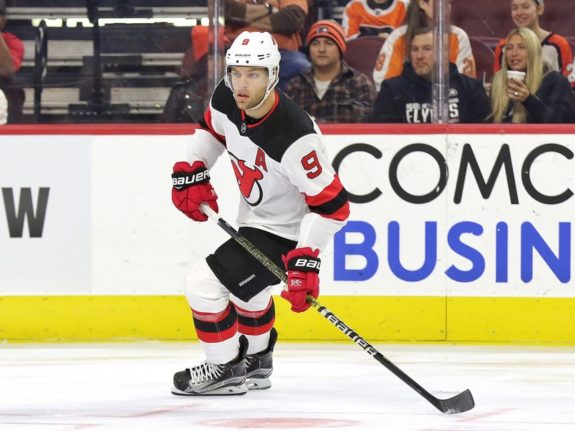The New Jersey Devils were not as active on defense as they were at forward this offseason. But they did make a significant addition when they traded for P.K. Subban on the second day of the NHL Entry Draft. They also re-signed restricted free agents Mirco Mueller and Connor Carrick to short-term deals.

It’s also fair to assume that top prospect Ty Smith will be playing in the NHL in 2019-20. Assuming he makes the team, the Devils’ blue line could have a fresh look when preseason action begins in about a month. So what could their defense pairs look like? Using Sean Tierney’s WAR Lineup Creator once again, I put together potential fits head coach John Hynes may use during game action.
WAR Lineup Overview
For this post, I’ll be focusing on how to get the best lineup on defense based on projected full season wins above replacement (ProjFSW). For those unfamiliar with wins above replacement (WAR), it measures how many wins a player adds to his team relative to a replacement-level player.
The numbers come from Evolving Hockey’s WAR model, which Tierney’s lineup creator manages to turn into full-season projections for a defense pair. It’s also important to note that a team’s top two pairs make up 37% of ice time each, while the bottom pair makes up for the remaining 26%.
Scenario 1: Vatanen Joins Subban on the First Pair
This lineup is what would be considered the “standard look,” given the roster. Sami Vatanen joins the newly acquired Subban on the top pair, while Will Butcher and Damon Severson find themselves as partners. Smith starts on the bottom pair with Andy Greene, the Devils’ most experienced defenseman.

There’s pretty much no argument that Subban will be on the Devils’ top pair. The question is who plays alongside him, and there are a few options. First up is Vatanen, who’s played on his weak side as recently as this past season. He may have the occasional defensive lapse or two, but he shoots the puck at a high rate and can generate offense. He’s also capable of logging big minutes as he averaged over 21 minutes per game in 2018-19, something Subban’s partner will need to be able to do.
The second pair of Butcher and Severson has potential. They’ve played together in the past and have positive results as a duo. They have an expected goals for percentage of 51.98% (xGF%) over the last two seasons, which is well above their 39.47% actual goals for percentage. One reason for that is their on-ice save percentage, which is 87.45% over that stretch. Some better goaltending while they’re on the ice, and they should perform closer to their xGF%.
Related: Devils 2019-20 Roster: What Are the Lines Going to Look Like
Unlike last season, the Devils’ would have some depth on their third pair. Greene has played top-four minutes for the Devils for as long as anyone can remember. But those days should be coming to a close as he’s struggled in that role for a few seasons. Playing on the third pair would mean softer minutes, which is best for him, given where he is at this point in his career. Smith will also benefit from going against easier competition, as Butcher did in 2017-18, making him the perfect fit with Greene.
Scenario 2: Top-Pair Butcher
This lineup consists of pairing everyone based on handedness. Butcher becomes Subban’s partner, while Smith jumps up a pair to join Severson. The last two spots are rounded out by Greene and Vatanen.

There are arguments for and against Butcher playing top-pair minutes. For starters, he has the best underlying numbers of the team’s defensemen and finished with a goals above replacement (GAR) of 9.8 in 2018-19 — the next closest was Severson, with a GAR of 2.4. On the flip side, he’s not a great skater, and while he’s not a bad defender, his defensive game still needs improvement. But he did see an increase in his minutes last season, meaning Hynes could be getting more comfortable giving him a larger role.
Smith is a bit of an unknown, given he’ll be making the jump from the WHL to the NHL. But it would be a mistake to rule him out for top-four minutes. He showed flashes of brilliance and the ability to move the puck last preseason, so the potential is there. Severson has earned his spot in the top four after a career-best season in 2018-19. With his ability to move the puck effectively in transition, he could be a good fit alongside a rookie like Smith.
Related: Subban is What the Devils’ Blue Line Needs
Having Vatanen as a third-pair defenseman wouldn’t be ideal, but it is a possibility. His previous results with Greene aren’t encouraging — they have a 48.78 xGF% in 670-plus minutes together over the last two seasons. But those were in harder minutes, which they won’t be getting on the bottom pair. Going against softer competition could also help Vatanen focus more on creating offense, which is more of his strength.
Scenario 3: Severson Gets His Chance
Vatanen gets a shot on playing his weak side in Scenario 1. So why not Severson? He moves up to the first pair to play with Subban, while Butcher and Vatanen make up the team’s second unit. The last two spots are once again rounded out by Greene and Smith.

Their 0.3 ProjFSW isn’t great, but that’s partly due to Subban’s down season, where he finished with a minus-0.1 WAR. If he’s able to rebound, which evidence suggests he can, they could end up beating out their projections (the same is true of any pair with Subban on it).
As for Severson, he’s coming off his best season yet. His transition game is among the best on the team, and it even compares to Subban’s. He enters the offensive zone with puck possession at a high rate, and he does the same when exiting the defensive zone. He also does a more than adequate job of defending his blue line.

For their second pair, Butcher and Vatanen are an ideal fit. They’ve logged almost 300 minutes together at five-on-five the last two seasons and have had a ton of success. Here’s how their CF%, xGF%, scoring chances for percentage (SCF%), and high-danger chances for percentage (HDCF%) stack up:
- CF%: 54.88%
- xGF%: 52.77%
- SCF%: 55.64%
- HDCF%: 57.14%
That’s from a pretty decent sample size, too. If Severson and Subban manage to gel together, while Butcher and Vatanen continue to build off past success, they have the potential to give the Devils the most balanced top four from these scenarios.
There isn’t much that changes in this lineup for Greene and Smith. But having a third pair that can produce positive results can go a long way. In their run to the playoffs in 2017-18, Butcher and Ben Lovejoy gave the Devils a reliable third pair with incredible depth. And that’s the hope for Greene and Smith as fifth and sixth defensemen.
Devils’ Blue Line Shouldn’t Be a Liability
Similar to the situation up front, Hynes will have options to find the right lineup. Butcher is ready for an increased role, and the Devils are hoping so after re-signing him to a three-year deal. Subban may be coming off his worst season, but he’s still the best defenseman they’ve had since Brian Rafalski was on the team. He’s also going to be a big help for their power play, which should have some firepower, especially with a healthy Taylor Hall and the addition of Nikita Gusev.

They also have two capable depth defensemen in Mueller and Carrick, both of who could step into the lineup when needed. Vatanen will contribute one way or another, even if his minutes come down. And players like Greene and Smith should help add to their depth, too. It’s not going to be the best blue line in the NHL by any stretch. But it should be good enough where it isn’t the reason they’re losing games consistently. And that’s a noteworthy change from previous seasons.
* * *
Advanced stats from Natural Stat Trick, Evolving Hockey. All lineups created using Sean Tierney’s WAR Lineup Creator